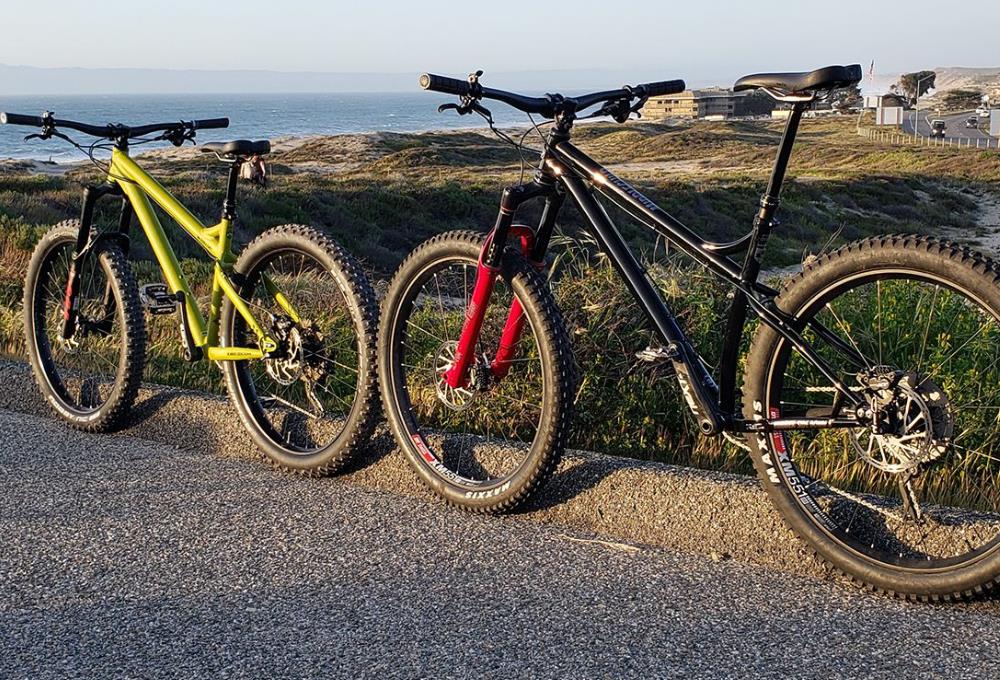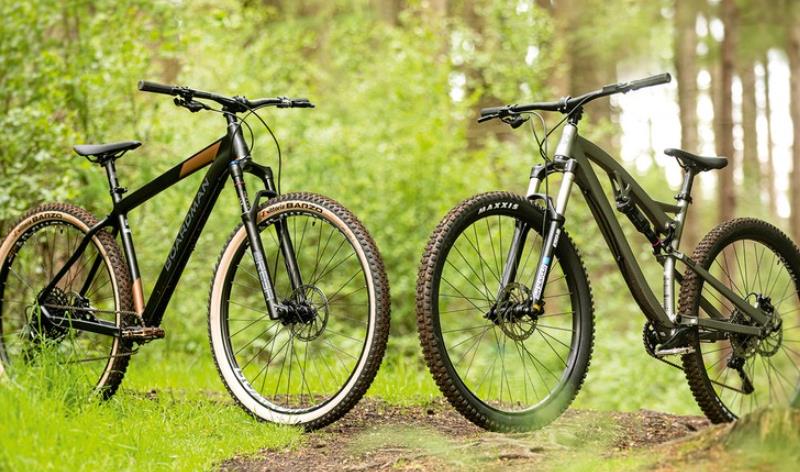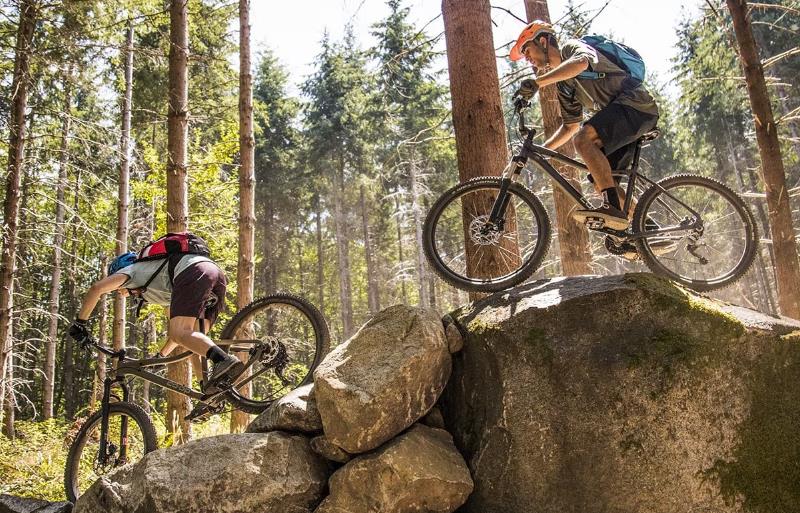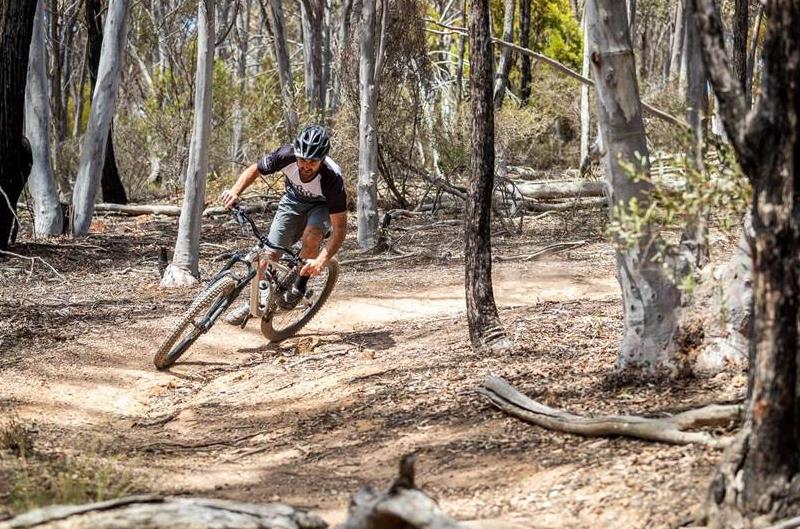The fact that mountain biking offers so much variety makes it a popular sport. You can opt to ride on pavement, rocks, or one of the many diverse trails available to cyclists of various skill levels. The various styles of suspension that are available are another aspect that contributes to mountain biking’s greatness.
The springs and dampers that make up a mountain bike’s suspension system serve to decrease the impact of track flaws. It not only makes riding more pleasant, but it also aids in maintaining control of your bicycle over uneven terrain. More comfort and traction on uneven, rocky singletrack or trails is what you can expect. Depending on your riding style and the terrain you ride on, you might favour a different kind of suspension.

The two most common types of mountain bike suspensions you’ll come across are hardtail and full suspension. It’s crucial to select the appropriate suspension for your riding style because it may make or break your ride.
Related Read: How to Do Mountain Biking With a Child?
What Is a Hardtail?

These mountain bicycles have a rigid, unsuspended frame and often have a front suspension fork but no back suspension. They’re a common option for novice off-roaders due to their lighter weight and affordable price.
What Is a Full Suspension?
Full-suspension mountain bikes, also referred to as dual-suspension mountain bikes, have both front and rear suspension, as the name implies. The addition of a rear shock makes these motorcycles more efficient and comfortable to ride in harsh off-road conditions. The bike’s handling and traction are improved by the rear shock, which also benefits rider comfort.
The decision between these two types will depend on a number of elements that I’ll go into below.
Related Read: How to Choose the Right Mountain Bike?
Weight
Weight is one of the most noticeable differences between a hardtail and a full-suspension motorcycle. A hardtail mountain bike is typically at least one kilogramme lighter than its full suspension cousin because it does not have pivots, a rear shock, or suspension linkages to add to its weight. This has significant climbing efficiency implications.
Terrain
Where you plan to ride your mountain bike is another factor to take into account when making your selection. Although both full suspension and hardtail bikes can handle a variety of challenging terrain, your ride experience won’t be the same.
Full-suspension bikes feel much smoother to ride on tough terrain because of their rear shock. This means this type may be your best option if you want to travel as far from the usual path as possible on a bicycle. They can also be a suitable option for novice riders because the rear suspension helps reduce rider fatigue by absorbing much of the anticipated off-road vibration. This could help you follow more experienced riders.
Hardtail bikes might give you a bumpier ride without the additional suspension in the back, but that isn’t always a negative thing. You can ride the same trails that a full-suspension bike can, but you’ll need to choose your lines more carefully and try to stay away from the root-lined and rockier parts of the trail whenever you can!
Climbing vs Descending

Both hardtail and full-suspension bikes have advantages when it comes to hills, but it will depend on whether you’re ascending or descending them. Riders choose hardtail mountain bicycles for long climbs due to their rigid rear end, lighter frame, and steady riding position.
Nevertheless, when it comes to flying back down those hills, full-suspension bikes shine. Due to the riding position and installed rear suspension, which provides you with more control, particularly on steeper dips, these bikes are excellent for racing down hills. Depending on how challenging and treacherous the terrain is, full suspension bikes may also be the best choice for climbing hills, with the suspension helping to keep your back tyre on the ground as you grind your way up the ascent.
Comfort and Traction
Comfort and traction are the two key benefits of a full-suspension bicycle. Although hardtail bicycles give you the chance to show off your traditional mountain biking abilities, dual suspension bikes provide you with the comfort and grip necessary to tackle tough terrain with confidence, especially if you’re a novice.
The rear suspension, which assists in keeping the wheel on the trail by tracking over any obstructions, is responsible for increased comfort. You also gain more traction when the rear wheel is firmly planted on the ground. It’s not that hardtails don’t provide you with good traction; in fact, you won’t even notice the difference between the two on softer ground. However, the full suspension really shines when the terrain gets rough.
Speed

Because of their lightweight frames and fixed riding positions, people frequently assume that hardtails are the fastest option for less difficult riding. In certain cases, this is correct. You can maximise your pedalling because these bikes are lighter and provide a closer touch to the ground. This is why they are the most popular for cross-country racing since they enable riders to zoom across a variety of varied terrain at peak speed.
But when you encounter very tricky terrain, full-suspension bikes are unquestionably the faster option. Although these bikes are heavier, their extra suspension allows you to navigate even the most difficult trails with ease, saving you time to navigate obstacles, choose your route of travel, and maintain your balance.
Price
Another important consideration when choosing between a hardtail and a full-suspension bike is price. Simply because they have more parts and a more complex frame, full-suspension mountain bikes cost more than hardtails with equal features.
A hardtail bike is the perfect choice if you’re on a limited budget and want to get the most for your money. Regardless of budget, these mountain bikes are above all very capable machines. But if you’re searching for something that will easily navigate difficult trails, then a full-suspension bike is the way to go. Their added suspension really helps on tricky terrain, allowing you to enjoy a smoother ride as you learn how to ride your new bike.
The post The Great Mountain Bike Debate: Hardtail vs. Full-Suspension appeared first on Travel Experta - Travel, Lifestyle, Freedom.
------------------------------------------
By: Marina 'Travel Experta'
Title: The Great Mountain Bike Debate: Hardtail vs. Full-Suspension
Sourced From: travelexperta.com/the-great-mountain-bike-debate-hardtail-vs-full-suspension/
Published Date: Wed, 21 Jun 2023 19:45:08 +0000
Did you miss our previous article...
https://consumernewsnetwork.com/travel-news/rent-a-campervan-in-new-zealand-tips-and-recommendations






